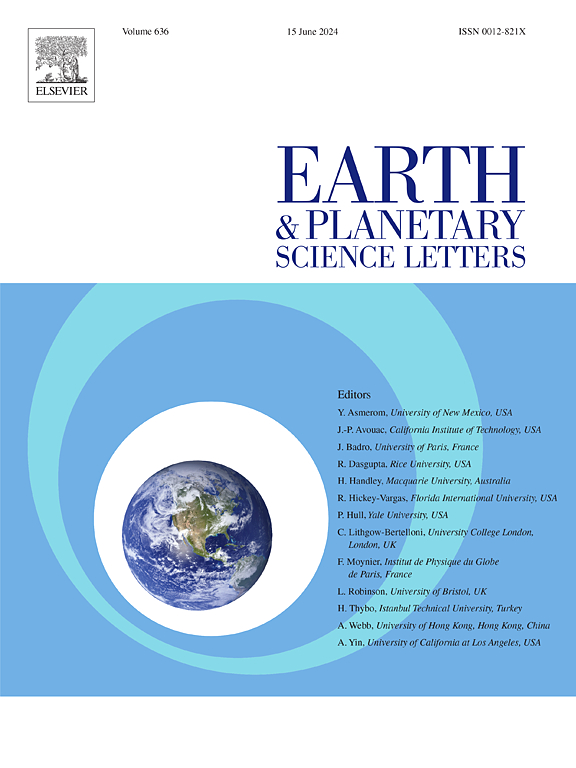大洋地壳脉络记录了板块冷却引起的开裂与海洋化学之间的动态相互作用
IF 4.8
1区 地球科学
Q1 GEOCHEMISTRY & GEOPHYSICS
引用次数: 0
摘要
当大洋地壳远离扩张脊时,低温热液矿物填充裂缝形成矿脉,改变了大洋地壳的物理和化学性质,同时也改变了海水的成分。从国际大洋发现计划(IODP)南大西洋横断面(南纬 31°)和以前的科学大洋钻探孔中收集的矿脉宽度和频率观测结果表明,矿脉宽度分布逐渐扩大,观测到的应变(Σmveins/mcore)随着地壳年龄的增加而增加,而矿脉密度(#veins/mcore)则大致保持不变。元素绘图和纹理观测表明,随着大洋地壳年龄的增长,会发生多次沉淀和断裂。这对现有的洋壳矿脉是被动填充的观点提出了挑战;相反,它们是洋壳老化的动态特征。这些数据与热应变建模相结合,表明了一种正反馈机制,即大洋板块的冷却会诱发开裂,并重新激活先前存在的矿脉,最终导致进一步冷却。这种反馈的减弱为全球平均热流异常的终止提供了一种机制。总矿脉扩张程度大于其年龄预期的地点,与大气中二氧化碳含量较高时期的地壳形成相吻合。因此,矿脉物质的数量反映了大洋板块冷却、海洋化学和大洋地壳年龄之间不断变化的平衡。我们的研究结果表明,大洋地壳在形成后的数千万年里一直是一个活跃的地球化学库。本文章由计算机程序翻译,如有差异,请以英文原文为准。
Ocean crustal veins record dynamic interplay between plate-cooling-induced cracking and ocean chemistry
As ocean crust traverses away from spreading ridges, low-temperature hydrothermal minerals fill cracks to form veins, transforming the physical and chemical properties of ocean crust whilst also modifying the composition of seawater. Vein width and frequency observations compiled from the International Ocean Discovery Program (IODP) South Atlantic Transect (∼31°S) and previous scientific ocean drilling holes show that vein width distributions progressively broaden and observed strain increases with crustal age, whereas vein densities remain approximately constant. Elemental mapping and textural observations illuminate multiple precipitation and fracturing episodes that continue as the ocean crust ages. This challenges the existing notion that ocean crustal veins are passively filled; rather, they are dynamic features of ocean crust aging. These data, combined with thermal strain modelling, indicate a positive feedback mechanism where cooling of the ocean plate induces cracking and the reactivation of pre-existing veins, ultimately resulting in further cooling. Waning of this feedback provides a mechanism for the termination of the global average heat flow anomaly. Sites with total vein dilation greater than expected for their age correspond with crustal formation during periods of high atmospheric CO2. The amount of vein material thus reflects the changing balance between ocean plate cooling, ocean chemistry, and the age of the ocean crust. Our results demonstrate that ocean crust endures as an active geochemical reservoir for tens of millions of years after formation.
求助全文
通过发布文献求助,成功后即可免费获取论文全文。
去求助
来源期刊

Earth and Planetary Science Letters
地学-地球化学与地球物理
CiteScore
10.30
自引率
5.70%
发文量
475
审稿时长
2.8 months
期刊介绍:
Earth and Planetary Science Letters (EPSL) is a leading journal for researchers across the entire Earth and planetary sciences community. It publishes concise, exciting, high-impact articles ("Letters") of broad interest. Its focus is on physical and chemical processes, the evolution and general properties of the Earth and planets - from their deep interiors to their atmospheres. EPSL also includes a Frontiers section, featuring invited high-profile synthesis articles by leading experts on timely topics to bring cutting-edge research to the wider community.
 求助内容:
求助内容: 应助结果提醒方式:
应助结果提醒方式:


